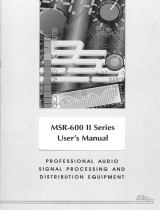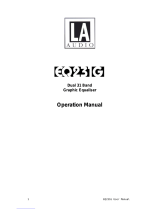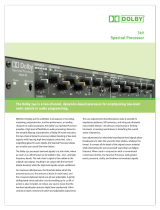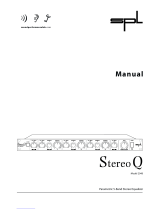Page is loading ...

1
This Manual is the COPYRIGHT of BSS Audio. All reproduction and copying, other than for the legal
owner's personal use, or disclosure of part or whole to a third party, without prior written authorisa-
tion, is in violation of the European Copyright Convention. BSS Audio 1995
DPR-901ii
User's Manual

2
DPR-901ii
Welcome to the DPR-901ii Users Manual
ABOVE AND BELOW THRESHOLD DYNAMIC
PARAMETRIC EQUALISATION.
This manual is provided with the aim of assisting sound engineers,
producers, musicians, system installers and consultants to fully under-
stand the DPR-901ii, and to benefit from it’s maximum capability.
As opposed to most manuals, the contents can be read like a book. At
the same time, the information is structured under a series of broad
headings for easy access. So where possible within each section:
!!
!!
! The most immediate information appears at the head of each
section under the main title.
!!
!!
! As you read further into each subsequent section, more detailed,
specific information is given.
If you have any comments or questions about installing, setting-up or
using the DPR-901ii, please write to us about your application, at the
address in the warranty section.
DPR-901ii
Welcome
V1.1 9 August 1995
This equipment has been tested and found to comply with the
following European Standards for Electromagnetic Compatibility.
Emission Specification EN55013 1990 (Associated equipment)
Immunity SpecificationEN50082/1 1992 (RF Immunity, Fast
Transients and ESD)
Mains Disturbance EN61000/3/2 1995
For continued compliance ensure that all input and output cables are
wired with cable screen connected to pin 1 of the XLR. The input XLR pin
1 on BSS equipment is generally connected to chassis via a capacitor to
prevent ground loops whilst ensuring good emc compatibility.

3
Table Of Contents
Table Of Contents
1.0 Introduction 4
1.1 Features and Facilities 5
2.0 Installation 6
2.1 Unpacking 6
2.2 Mechanical Installation 6
2.3 Mains Power 7
2.4 Voltage Setting 8
2.5 Safety Earthing 8
2.6 AC Power Fusing 8
2.7 Audio Connections 9
2.8 Ground Loop Control 10
3.0 Controls 11
4.0 Principle of operation 16
5.0 Using the DPR-901ii 18
6.0 Warranty Information 20
Appendix A 21
A1 Chassis/0v Link Removal 21
A2 Input pin 1 to Chassis Connection 22
A3 Transient Suppressor Replacement 22
Appendix B 23
Technical Specifications 23
Appendix C 25
Glossary 25
User Notes 28

4
DPR-901ii
1.0 Introduction
Introduction
Congratulations!. Whether you’re a sound engineer, producer, consult-
ant, installer or musician, you’ve just added a powerful new weapon to
your audio armoury.
The DPR-901ii is a new class of audio equaliser. Both subtle and power-
ful, it builds on the established problem solving capabilities of paramet-
ric equalisers.
It’s uses range from processing and sweetening speech, instruments and
composite music, through SPL control, to loudspeaker system and room
tuning. The DPR-901ii refines the EQ process, makes it more specific -
and expands it too.
For the first time, changes in EQ and signal dynamics at the EQ’d fre-
quency can be created which are triggered either above or below the
individual threshold levels in four adjustable frequency bands. The
changes in tonality can range from the subtle and highly specific, up
to the extremes of instrument effects. Either way, the DPR-901ii’s unique
subtractive process coupled with state-variable equalisation ensures
uncoloured, low distortion sound. Group delay in particular is low and
uniform, maintaining vital accuracy in the time/transient domain that is
lacking in the majority of conventional equalisers with ‘Bell’ response
envelopes.

5
Features and Facilities
1.1 Features and
Facilities
The DPR-901ii is a four band parametric equaliser which varies the
degree of equalisation dynamically, as the program level changes. The
process can be thought of as frequency selective compression and/or
expansion, but it is fundamentally different to simple ‘frequency-con-
scious’ dynamics processing as used for noise gating, de-essing and the
like. It is also very different to the growing family of ‘sliding filter’ tech-
niques used in single-ended noise reduction processors. A split facility
allows the unit to be used as two separate two band units, and a side
chain listen button allows monitoring of the filter setup.
Frequency selective compression is equivalent to applying CUT on a
normal equaliser while frequency selective expansion is like applying
BOOST. However, the DPR-901ii can be more subtle as the process is
dynamic: it will only occur above (or below) the threshold you have set.
Some possible uses for the DPR-901ii technology can be:
!!
!!
! To selectively compress and/or expand, broad or narrow-band seg-
ments of program.
!!
!!
! To de-ess and de-pop.
!!
!!
! To add dynamic loudness control (eg. bass boost at low SPLs).
!!
!!
! To control SPL in a dynamic and frequency conscious manner.
!!
!!
! To enhance or ‘sweeten’ mixed programme.
!!
!!
! To improve voice intelligibility (without risking howlround or feed-
back).
!!
!!
! To enhance low level vocals.
!!
!!
! To correct for and/or guard against, bad microphone technique (by
unskilled performers).
And in common with other units in BSS Audio’s processor range, the
DPR-901ii features:
!!
!!
! Friendly rotary control knobs for all parameter adjustments.
!!
!!
! Excellent low level resolution to maintain subtle musical detail.
!!
!!
! Minimum phase and low group delay for any EQ setting.
!!
!!
! High headroom >+ 20dBu.
!!
!!
! Conservative drive capability into low impedances (down to 600
ohms) and long, highly capacitive cables.
!!
!!
! Automatic relay controlled signal bypass if mains power is discon-
nected or fails.
Altogether, the DPR-901ii will not degrade a conventional high quality
analogue signal processing chain, even when two units are inserted in
line with the composite stereo mix.

6
DPR-901ii
Installation
Unpacking
Mechanical Installation
As part of BSS AUDIO’s system of quality control, this product is
carefully checked before packing, to ensure flawless appearance.
After unpacking the unit, please inspect for any physical damage and
retain the shipping carton and all relevant packing materials for use
should the unit need returning.
A packet of spare fuses is supplied. Please keep them in a safe place.
If any damage has occurred, please notify your dealer immediately, so
that a written claim for damages can be initiated. See the Warranty
section of this manual.
A vertical rack space of 1U (1.75", 44.5mm) is required. Figure 2.1
details the relevant dimensions and fixing centres.
If the unit is part of a transportable system, you must support the unit at
it’s rear by additional bracing or shelving . Failure to do so will impair
reliability and invalidate the Warranty. Additional threaded M3 screw
holes are provided on the rear sides to assist in providing proper
support.
Adequate ventilation must be provided for by allowing sufficient room
around the sides and rear of the unit to allow free circulation of air.
Forced cooling is not required.
2.0 Installation
2.1 Unpacking
Fig. 2.1 Mechanical
Dimensions
2.2 Mechanical
Installation

7
Mains Power
The internal power supply regulators are mounted on the case sides
and use this as their heatsink. After a period of time in an enclosure,
the metal case will feel hot to the touch, but this is quite normal and
should not be a cause for alarm.
Before connecting your unit to its AC power source, check that the
voltage selector switch located on the rear panel is correctly set.
See figure 2.2.
WARNING: THIS APPLIANCE MUST BE EARTHED.
IMPORTANT: The wires in this mains lead are colour coded in ac-
cordance with the following code:
Green and yellow......Earth
Blue......Neutral
Brown......Live
As the colours of the wires in the mains lead of this appliance may not
correspond with the coloured markings identifying the terminals in
your plug, proceed as follows:
The wire which is coloured green and yellow must be connected to
the terminal in the plug which is marked with the letter 'E' or by the
earth symbol , or coloured green and yellow.
The wire which is coloured blue must be connected to the terminal
which is marked with the letter 'N' or coloured black.
The wire which is coloured brown must be connected to the terminal
which is marked with the letter 'L' or coloured red.
Those units that are supplied to the North American market will have an
integral moulded 3 pin connector which is provided to satisfy the area
safety standards.
Fig. 2.2 Mains Voltage
Switch and Fuse
2.3 Mains Power
FOR CONTINUED PROTECTION AGAINST FIRE
REPLACE ONLY WITH THE SAME TYPE OF FUSE
SELECT VOLTAGE
AC 50/60Hz 40 WATTS MAINS POWER T250mA 230V
T315mA 115V
MAINS SUPPLY
ON DESIGNED & MANUFACTURED BY BSS AUDIO Ltd. ENGLAND

8
DPR-901ii
Voltage Setting
Safety Earthing
AC Power Fusing
2.4 Voltage Setting
The mains voltage selector switch provides a simple external adjustment
to allow operation on all international AC power standards. The allow-
able ranges for the supply voltage are:
96VAC up to 132VAC on the 115V position and
195VAC up to 264VAC on the 230V position.
An additional internal tap change is available for 100V working. Refer
to Appendix A.2. The tap change gives:
90VAC up to 110VAC on the 120V position
Outside these ranges the unit will not work satisfactorily, if at all.
Voltages in excess of the maximum will probably cause damage.
Voltages below the minimum will cause the power supplies to drop
out of regulation, degrading the performance of the system.
The Green and Yellow wire of the mains cord must always be con-
nected to an installation Safety Earth or Ground. The Earth is essential
for personal safety as well as the correct operation of the system, and
is internally connected to all exposed metal surfaces. Any rack frame-
work into which this unit may be mounted is assumed to be connected
to the same grounding circuit.
The incoming mains power is fused within the DPR901ii by the fuse
holder mounted on the rear panel. Should it be necessary, the fuse
must be replaced by one of the same size and current rating.
20mm T250mA for the 230V setting
20mm T315mA for the 115V setting
It is most important for continued safety that this specification is strictly
adhered to. Spare fuses of the correct rating are supplied with the unit
from new.
It is unlikely that the AC fuse will fail during normal use and caution
should be exercised if it does. The most likely reason at first power up
is the incorrect setting of the mains voltage switch on the rear panel.
Alternatively the unit may have been connected across two lines of a
three phase supply. In both of these cases the internal transient sup-
pressors may have been damaged and will continue to blow replace-
ment fuses, even if the supply is now correct. The suppressors will
have protected the DPR-901ii from damage and need replacing
before the unit can be used again.
Refer to Appendix A.1 for the replacement procedure.
2.5 Safety Earthing
2.6 AC Power
Fusing

9
Audio Connections
2.7 Audio
Connections
Fig. 2.3 Input and
Output Connector
Wiring
The DPR-901ii audio inputs are RFI filtered and electronically balanced,
with the outputs electronically balanced and floating. They are designed
to operate at any signal level up to +20dBu and will drive into loads of
600 ohms or greater. They will be ‘fuss free’, regardless of your installa-
tion’s complexity. Figure 2.3 shows the connector wiring.
Whether your system is wired to a ‘pin 3 hot’ or a ‘pin 2 hot’ convention
will not matter as long as your wiring to both the input and output 3 pin
XLR connectors are the same . As is common with all other BSS equip-
ment of this type, we follow the convention of ‘screen goes forward with
the signal’. Input cable screening therefore needs to be derived from the
signal source end as pin 1 is ground lifted at low frequencies for the
inputs. If you wish to alter this please see appendix. You should use high
quality audio cable with 2 cores + screen for low noise and reliability,
and to sidestep potential problems.
If the equipment driving the DPR-901ii has unbalanced outputs then
you will need to add a wire jumper such that the screen connection
on Pin 1 of the XLR is shorted to either Pin 2 or Pin 3, depending on
system convention.
If the equipment being connected to the DPR-901ii outputs have only
unbalanced inputs, then we recommend that you still use a balanced (ie.
2 core shielded) cable. You should connect the shield to pin 1, whilst the
cold connection should be used as the 0v reference and the hot connec-
tion for the live, on the unbalanced input. The cable screen should not
be connected through to the chassis/0v. Strict adherence to this will help
to eliminate potential ground loop hums.
Unbalanced Wiring
Balanced Wiring

10
DPR-901ii
Ground Loop Control
2.8 Ground Loop
Control
Strict adherence to the wiring conventions noted above within a fully
balanced signal system will yield the best possible results with none of
the problems normally associated with interconnected audio equipment.
Wherever possible, cable screens should not be connected to any signal
pin, but rather left to perform a cable shielding function only.
Where it is not possible to control all of the external cabling, it might
become necessary to have the internal electronic ground of your unit
separated from the case safety ground. Provision is made internally
within the DPR-901ii to separate these two grounds at a convenient
point, or to add a suitable impedance network as part of a house system
requirement. Please see appendix.
Under no circumstances should the safety ground wire be removed from
the mains AC power connector as an interim measure to achieve similar
results.

11
Controls
3.0 Controls
1
53
761012 14
9
211 1 315
4
8
1 EQ IN
2 Output Display
3 SIDE CHAIN LISTEN
When depressed, the processing is engaged and the LED (underneath)
lights in confirmation. When released, processing is disabled; the LED is
off and the incoming signal passes to the output unchanged and at unity
gain (0dB). Note: As the DPR-901ii’s entire signal path is bypassed in this
mode, signal will be passed to the output even if the AC power is discon-
nected - or fails. In split mode the input signals are bypassed to their
relevant split output.
The lower green LED displays presence of incoming signal. The three
LED bar above shows available headroom. If the uppermost ‘CLIP’
LED lights (indicating overload), reduce the drive level. Otherwise,
check system connections for inadvertent loops causing feedback.
Pressing this momentary button sends the side chain audio signal of any
active band to the output. This will include any filtering, and allows you
to set up the signal that will subsequently be removed or expanded by
the dynamics processing.
This led lights to indicate that the split switch on the rear panel is in the
‘split’ position.
All the remaining controls relate to the four frequency conscious bands.
Reading from left to right, these cover Low, low-Mid, high-Mid and
High and the controls for the four bands are mainly identical.
4 SPLIT led

12
DPR-901ii
Controls
1
53
761012 14
9
211 1 3154
8
When depressed, the band is operative. The LED underneath lights.
When released, the band is bypassed. This is useful for dropping out
effects when they’re not needed (without disturbing the other settings),
and for A/B comparisons.
Turn to set the centre frequency of the dynamic activity. Note that the
range of each band overlaps the next, so for example, the low-Mid
control covers the same ground as the upper portion of the bass band
and the lower portion of the high-Mid band. This is useful if say, the
bass has to provide processing at 60Hz but a different process is also
required at 160 and another at 900Hz.
Controls bandwidth or ‘Q’. Turn clockwise to widen or defocus the
affected band of frequencies. Turn anti-clockwise to narrow or sharpen
the affected band. Irrespective of WIDTH setting, the band is always
centered on the frequency set with the FREQUENCY knob (above),
covering an equal number of octaves or fractions of an octave either
side.
(Band one and band four only). Switches the filter from a bell to a
shelving response. See fig. 3.1. With the bell response, the process
sensitivity is reduced symmetrically either side of the selected centre
frequency. When the shelf response is selected, the process sensitivity
increases until it reaches a plateau. Thereafter it remains constant
below the LF (bass) centre frequency, and above the HF (treble) centre
frequency.
5 IN
6 FREQUENCY
7 WIDTH
8 FILTER/SHELF

13
Controls
(Band two and band three only). Switches the EQ from a bell response to
a flat (wide-band) response. With the bell response, the process sensitiv-
ity is reduced symmetrically either side of the selected centre frequency.
When the Defeat setting is selected by depressing the button, the af-
fected band becomes EQ-less, like a conventional compressor/expander:
it responds to all frequencies equally. This facility allows ordinary com-
pression/expansion to be used alongside and in addition to effects estab-
lished using the three (remaining) bands of frequency sensitive compres-
sion/expansion.
When this control is set centrally (at 12 o’clock), the dynamic effect is
nil. When turned to the left, the band is compressed. When turned to
the right, the band is expanded. However, expansion or compression
is conditional as it only occurs if the signal level is above threshold (or
below threshold dependent on switch 14), as indicated on meter 13. The
degree of compression or expansion is indicated on meter 11. The
compression or expansion ratio progressively increases as the knob is
turned away from the centre and is soft-knee close to the centre, becom-
ing harder (more like a limiter) with more extreme settings. Maximum
compression is +30dB and maximum expansion is +16dB.
9 FILTER/DEFEAT
10 COMP-EXP
Fig. 3.1 Bell and Shelf
Filter Switching
0dB
LEVEL
FREQUENCY
Width
F
c
0dB
LEVEL
FREQUENCY
F
BAND 1
F
BAND 4

14
DPR-901ii
Controls
1
53
761012 14
9
211 1 3154
8
These horizontal LED displays give an instant, intuitive check on
whether the process in each band is active, by how much, and whether
it’s expansion or compression. The amount of expansion or compression
is indicated by an easy-to-memorise 1-8 scale, with ‘8’ indicating maxi-
mum (hard) compress or expand.
Turn to set the signal threshold level above (or below) which the effect is
to take place and is used in conjunction with LED meter 11. Turning
anti-clockwise reduces the signal level needed to exceed the thresh-
old, and therefore increases sensitivity. Signals exceeding threshold
initiate the selected processing. (Above threshold mode, see 12).
Turning clockwise increases the signal level needed and reduces
sensitivity. When set fully clockwise, the threshold is set to +20dBu.
Shows the input signal level in relation to the threshold you have set.
The central orange LED lights dimly as the threshold is reached and
then glows increasingly bright as the threshold is exceeded. When the
signal causes the red LEDs to be lit, signal is above threshold. The first
green LED indicates a signal level 12dB below threshold.
11 Compression/
Expansion Display
12 THRESHOLD
13 Threshold Display

15
Controls
When the switch is released, the processing operates above threshold,
that is with compression or expansion being applied only to signal levels
that exceed the threshold. When the switch is depressed to select Below,
the green led beneath the switch lights. The threshold’s sensitivity setting
remains the same, but the processing is ‘turned on its head’ as compres-
sion or expansion is now only applied to signals which are below the
threshold. Below threshold compression now works like a frequency-
sensitive gate in that the further below the threshold the signal is, the
more it is attenuated. There being progressively less attenuation as signal
level increases to approach the threshold setting. Below threshold expan-
sion acts to boost the selected frequency range up to (but not above) the
threshold. The expansion meter 9 will light under these low signal
conditions, slowly reducing as the input signal increases towards thresh-
old.
When the switch is released, the compress/expand time constants are
automatic. This is the normal setting if you’re using the DPR-901ii as a
leveller or otherwise processing a composite (mixed down) music signal.
When depressed for FAST, the compress/expand release time is speeded
up. This is likely to be the correct setting for less spectrally dense mate-
rial, normally single instruments, especially dynamic sources, ie. vocals,
percussion and any instruments played percussively.
14 BELOW Threshold
15 FAST RELEASE

16
DPR-901ii
Principle of Operation
The DPR-901ii is fundamentally different to ordinary de-essers, Dolby
systems and the like because it uses subtractive techniques to control the
degree of compression or expansion. This enables the VCA (gain control
element) to be kept out of the direct signal path. As a result, the through-
going signal is not subjected to the noise and distortion that’s intrinsic to
even the best VCAs. Moreover, the resultant filtered output exhibits far
less of the ‘time smearing’ that accompanies most conventional units and
has at times given equalisation a bad name. In fact, the subtractive VCA
technique can only operate correctly if the ‘passing through’ and ‘con-
trol’ signals at the subtractor are correctly aligned.
Figure 4.1 shows a simple block diagram that illustrates the principle of
operation of subtractive gain reduction and Fig 4.2 that with the addition
of filtering and invertor for gain addition or expansion.
Referring to figure 4.1, in operation the main signal path is simply
through the single inverting op-amp as the VCA is held at maximum
attenuation. When signal exceeds the set threshold level, the inverting
VCA is gradually opened, allowing a small ‘subtracting’ signal to pass to
the main inverting op-amp. Furthermore, this signal is also conditioned
by the filtering effect of the parametric filter. The resultant output is then
either reduced in level, or increased in level dependent on the ‘com-
press/expand’ switch, and it is only those frequencies passed by the filter,
that are so processed.
On the DPR-901ii, the threshold control is adjusting the voltage drive
level to the VCA, in conjunction with a fixed reference point, whilst the
‘compress/expand’ switch is replaced with a centre-off compress or
4.0 Principle of Operation
Fig 4.1 Subtractive
Gain Reduction
Fig 4.2 Subtractive
Gain Reduction or
Expansion

17
expand level control, whose function is similar to a ratio control on
conventional dynamic processors. The DPR-901ii Dynamic Equaliser,
with four separate sections of this processing, offers considerable
processing performance by adding another variable dimension to con-
ventional equalisation.
Principle of Operation

18
DPR-901ii
Using the DPR-901ii
5.0 Using the DPR-901ii
Refer to the block diagram in Fig 5.1opposite.
We recommend you familiarise yourself with the normal above thresh-
old mode of operation before exercising the below threshold configura-
tion. The latter is more subtle in effect, and requires more precise adjust-
ments of level, especially in expansion.
For high sound quality it’s important that you set the input drive cor-
rectly, particularly when using the expansion mode. As is common for
all electronic equipment, care must be taken to ensure that the input
signal does not exceed the maximum internal clipping level (especially
when boosted by expansion) and the output headroom meter is therefore
an important display. When setting up you must ensure that on one
hand, your maximum signal peak does not exceed the ‘clip’ scale point
and on the other, is not so low that it’s wasteful of dynamic range. As the
optimum drive level depends on the exact processing applied, it should
be re-checked after initial setting and any subsequent fine tuning.
To set up the filter controls, the side chain listen switch can be used to
listen in to the actual signal that will be subtracted or added by the VCA.
This is especially useful if more than one band of processing is being
applied, as the overall effect of the filtering can be heard, before the
dynamic activity is applied. Only the side chains of those bands that are
selected IN will be routed to the output. NOTE: If no bands are selected
IN then nothing will be heard when the side chain listen switch is
pressed.
With the split switch in the MAIN position, the DPR-901ii is configured
as a single four band unit, and the input signal should be plugged into
the MAIN input, and the output should be taken from the MAIN output.
Side chain listen signals for all bands are routed to the MAIN output. The
relay bypass signal is routed from the MAIN input to the MAIN output.
The output signal from bands 1 & 2 is available at the SPLIT output, but
the SPLIT input is inoperative.
With the split switch in the SPLIT position, the DPR-901ii is effectively
split down the middle, and is configured as two independant two band
units. The frequency ranges remain unchanged.
For bands 1 & 2, the input signal should be plugged into the MAIN
input, and the output signal should be taken from the SPLIT output.
For bands 3 & 4 the input signal should be plugged into the SPLIT input,
and the output taken from the MAIN output.
Side chain listen signals are routed to their appropriate output, and the
relay bypass directly connects the MAIN input to the SPLIT output, and
the SPLIT input to the MAIN output.

19
Using the DPR-901ii
5.1 DPR-901ii Block
Diagram

20
DPR-901ii
This unit is warranted by BSS Audio to the original end user purchaser
against defects in workmanship and the materials used in its manufac-
ture for a period of one year from the date of shipment to the end user.
Faults arising from misuse, unauthorised modifications or accidents
are not covered under this warranty. No other warranty is expressed
or implied.
If the unit is faulty it should be sent, in its original packaging, to the
supplier or your local authorised BSS Audio dealer with shipping
prepaid.
You should include a statement listing the faults found. The unit’s serial
number must be quoted in all correspondence relating to a claim.
We recommend that you record your purchase information here for
future reference.
6.0 Warranty Information
Dealer Name:
Dealer Address:
Post/Zip Code:
Dealer Phone No.:
Dealer Contact Name:
Invoice/Receipt No.:
Date of Purchase:
Unit Serial Number:
IMPORTANT
Warranty Information
In keeping with our policy of continued improvement, BSS Audio
reserves the right to alter specifications without prior notice.
The DPR-901ii was designed, developed and produced by BSS Audio,
Hertfordshire, England.
Please note our phone numbers.
Phone (+44) (0)1707 660667. Fax (+44) (0)1707 660755.
/












